
There are 5 main types of feathers based on their structure:
- Down
- Semiplume
- Filoplume
- Contour
- Bristle
Down feathers have the least amount of structure. These have the very few barbs which is what gives feathers their shape. These feathers are closest to the bird and keep her warm.
Semiplume feathers have slightly more structure, but are a hybrid between a down feather and a contour feather structure.
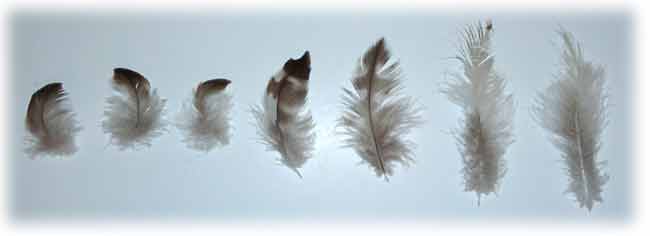 |
From the left, these are Down feathers. The two feathers on the right are Semiplume feathers. |
Filoplume feathers are almost hair-like. The "hairs" left on a plucked chicken are filoplume feathers.
Contour feathers have a lot of structure and are what give a bird her shape. These lay against the body and can be anywhere from very small to quite large and substantial on the bird. Flight feathers are the largest, most substantial, and most impressive of the contour feathers. These vary widely across the bird's body with regards to their shape, and vary from species to species. These are the tail feathers, the primaries and the secondaries found on the wings.
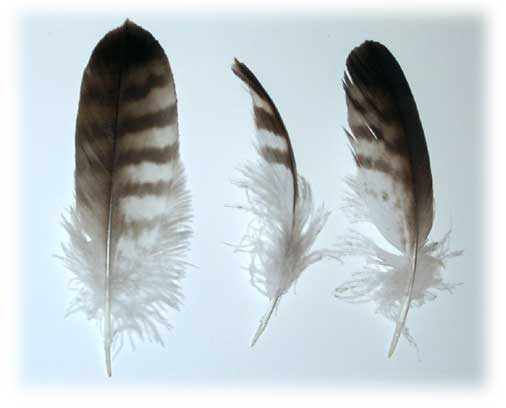 |
These three feathers are Contour feathers. The feather in the middle has been placed on its side to show the real shape of these feathers and the shape that they give to the bird. The two feathers on the outside are flat and come from the wing where they describe a flat surface, but the feather in the middle comes from the bird's chest and so it is rounded describing that chest shape. |
Bristle feathers are short stiffly shafted feathers typically found around the beak, nares, and eyes of many birds.
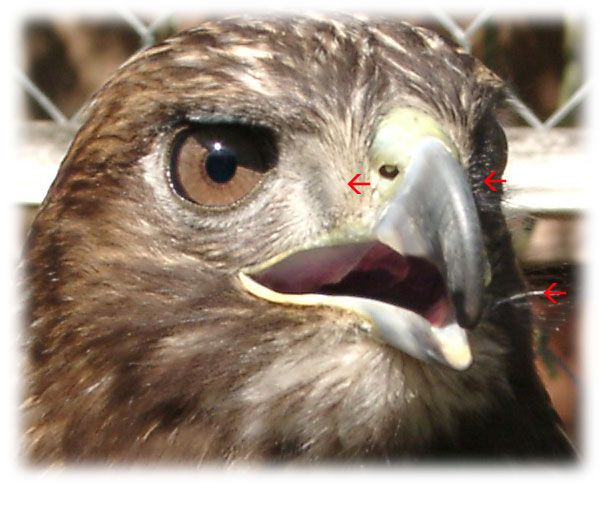 |
The arrows are pointing out these bristle feathers on a bird. |
In general, the feathers of hawks are far softer than the feathers of falcons, and the feathers of many owls are softer than either. The reason for this is that falcons are flying at very high speeds and must have stability and control over the entire surface area. Owl feathers are soft allowing air to flow over nearly soundlessly. Hawks, comparatively, are soft to the touch and have "puffy" feathers that make them look much larger than their body. A male Red-Tail may weigh 800g and appear quite imposing. And a male Saker may also weigh 800g and be a much more compact bird. Part of this is because their feathers are stiff and lay close to their body. Hawks just cannot maintain the stability at higher speeds as falcons can as they cannot control all that fluff. There is a continuum along which the birds lie as can be seen in the Goshawks whose tails are notoriously breaking due to their brittleness. However, considering their flight style (fast off the fist and highly maneuverable), this stiffness is easy to understand.
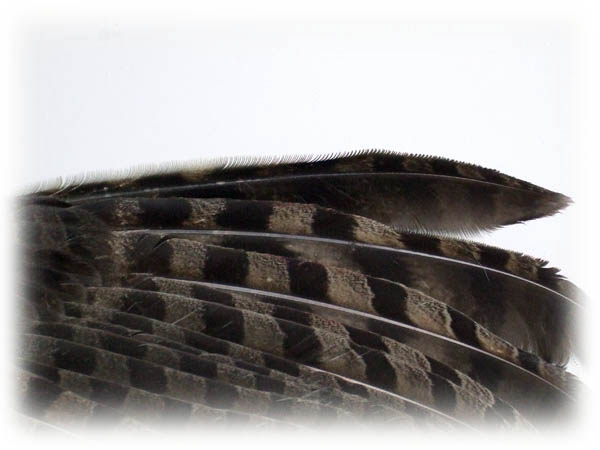 |
The edges of a Great Horned Owl's feathers are jagged and soft. |
Likewise, immature birds have much softer feathers than the mature birds. Some of the speculation on this is that immature birds need more cushion against bumps and tumbles and that immature birds do not care for their plumage nearly as well as mature birds do. Because of this immature birds are more frequently seen with feather breakage or feathers in need of straightening. Falconers will keep wing and tail feathers in case a bird breaks or damages a feather. The broken feather shaft can be carefully cut and a feather previously moulted can be substituted in. This process is called imping.
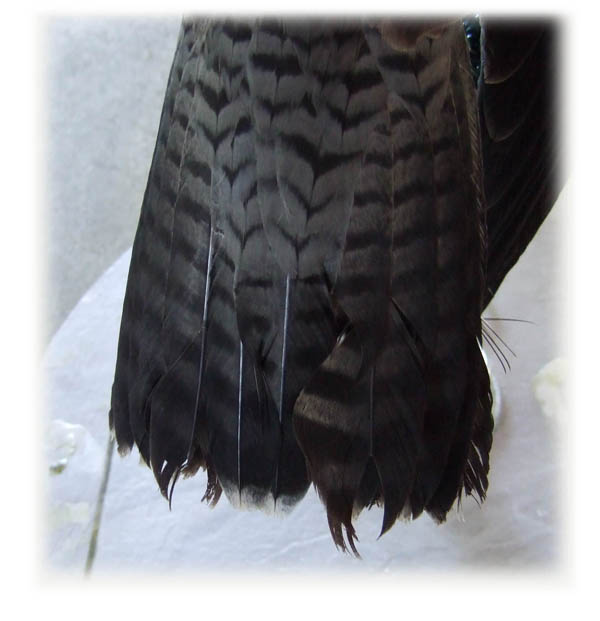 |
Minor damage to feathers. The tips of these feather have been broken, possibly from a perch, a leash, or sitting back on her tail while she eats. Cleaning by dipping in some Oxyclean, rinsing well, and sunning the bird may encourage her to preen and correct some of the damage. Minor bending and cracking of a feather can be resolved by putting a line of glue from a hot glue gun along both sides and the underside of the shaft. A small piece of a straw can also be used to splint the feather and support it to be stronger. |
The feathers at the tip of the bird's wings are the primaries - many people think of these like fingers as they are that important to the bird's ability to control her flight.
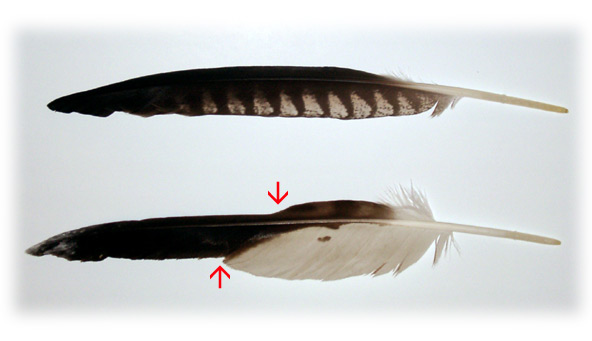
The feather on the top is from a falcon, which is in a different family than the hawks. Notice how smooth the edge is - it is not shaped with a notch as the other feather is. Falcons only have that soaring slot on the primary feather closest to the tip of their wing. All of their other primaries are smooth like this one.
The primary on the bottom is from a Red-Tail Hawk. Notice that it has a notch on it which creates a slot for airflow over the wing - a soaring slot. Hawks spend a considerable amount of time soaring and have evolved this notch that allows them to soar better. The feather itself is much broader than the falcon's - the hawk has broader wings than the falcon to better stay aloft without effort.
Here are two primaries from an immature Red-Tail Hawk's first moult. Notice how the two feathers are mirror images of each other coming from the same location but one from each wing.
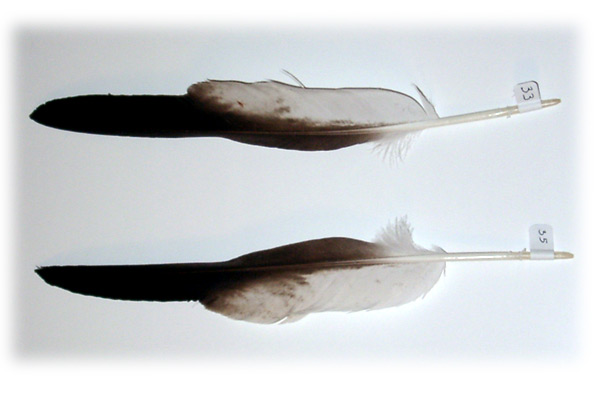
Both of these two tail feathers are from the same Red-Tail Hawk and from the same location on the tail.
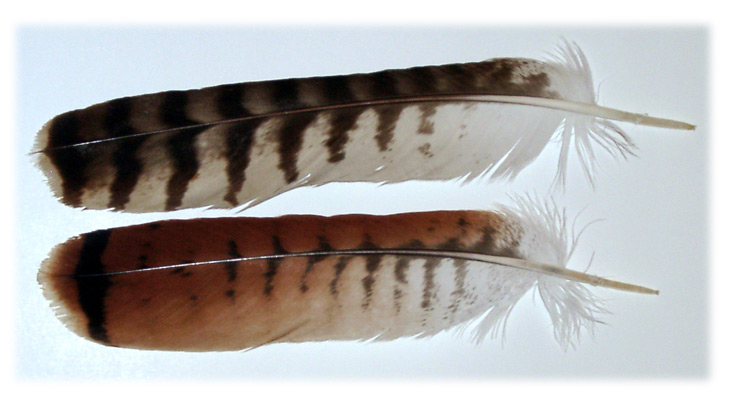
The feather on the top is from the bird's first moult when she drops her immature plumage. Notice the coloration of the immature bird's tail feathers - brown and tan striped.
The feather on the bottom is from her second moult when she dropped mature colored feathers and replaced them with similar feathers. Note how much smaller this feather is. The immature bird has much larger feathers than the same bird will as a mature adult. Current theories hold that this is to compensate for the bird's inexperience and give her an advantage in the wild.
Many bird feathers have bands or horizontal stripes across them. Here are two adult Red-Tail feathers from two different Western Red-Tails, one male and one female.
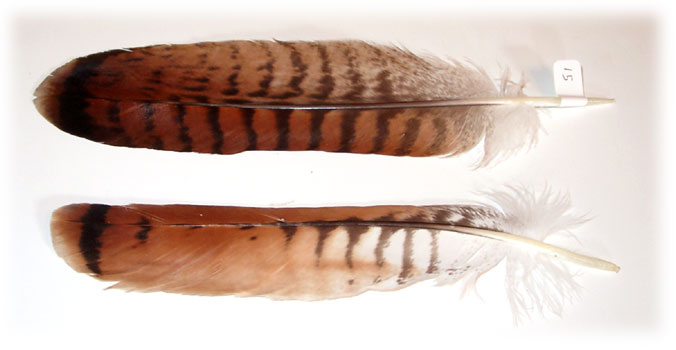
The feather on the top has more complete banding that runs the length of the tail feather. The feather on the bottom has much less banding, and none in some areas. Both have a terminal band, the black stripe that appears towards the tip of the feather.
Here a full tail from an immature Red-Tail Hawk's first moult is laid out. Notice how the two center deck feathers are nearly symmetrical while the outer most feathers are not nearly symmetrical, yet are mirror images of each other.
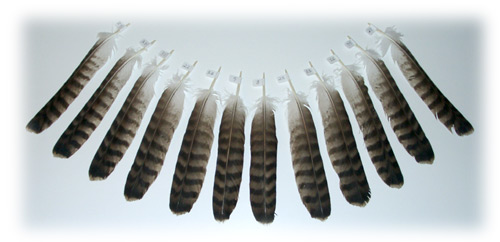
Flight feathers will inevitably become bashed and damaged over time. Feathers that are bent are easy to straighten with a little water. The easiest way to straighten a bent feather is to dip the feather in to a little warm water (hot water doesn't work any better, just a little warm water). As the feather dries, it will straighten. You may need to wet it several times, either dunking it, pulling it out to allow it to drip, and then dunking it again, or wetting the feather, allow it to dry, and then wetting it again. Cool water will also work if the bird bathes or gets wet from a shower. A broken feather will require imping to fix, though, a more involved process requiring the bird to be cast.
Moulted feathers or feather tips can also become dirty. One way to wash the feathers clean is to damped them, sprinkle a little OxyClean on the feather, gently work slightly, then rinse very well. Even whitewash will come off with this.
Feathers also reflect a bird's nutrition and general condition. If a bird is starving or has an imbalanced diet when she is producing new feathers, these feathers can have deformities called stress marks or hunger traces. These are weak points of the feathers.
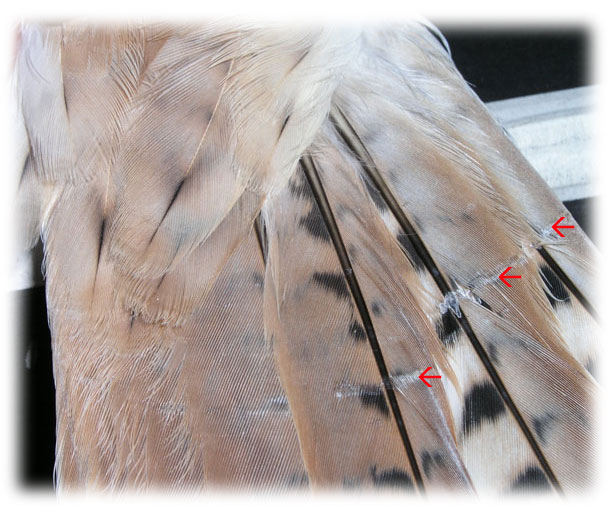
Photo courtesy of Marra Apgar.
Feathers can reflect disease in a bird. These feathers are from the same location on the same Peregrine Falcon - one was moulted out prior to contracting West Nile Virus, and the other was dropped shortly after the feather grew in as the bird was recovering from West Nile Virus.
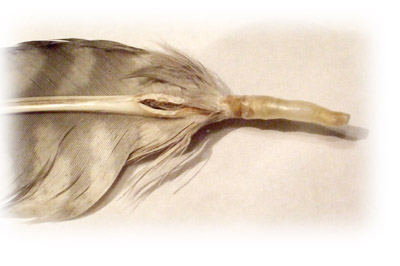
Notice the split in the feather shaft and the malformed shaft near the tip.
Feathers courtesy of Ron Kearney.
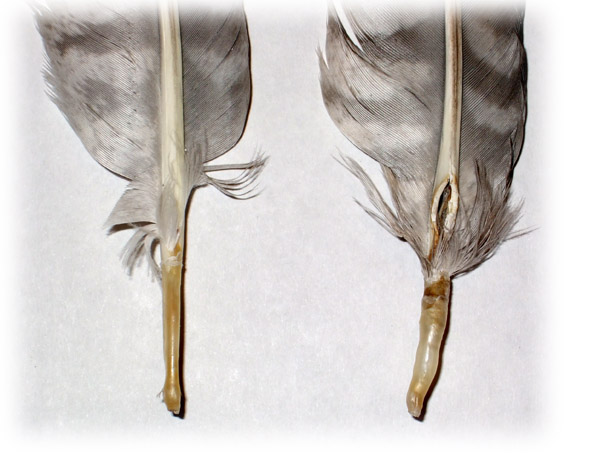
The feather on the left was moulted normally prior to contracting West Nile Virus. The feather on the right was dropped shortly after growing in. The feather on the right is substantially shorter than the normal feather and the shaft is warped and twisted.
Feathers courtesy of Ron Kearney.
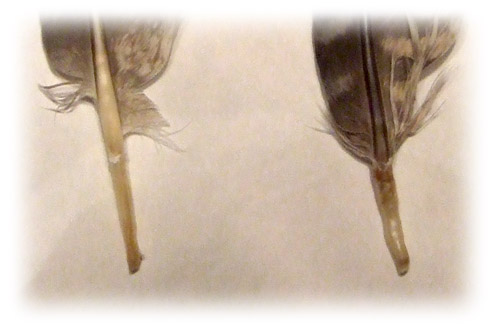
Another comparison of these two feathers.
Feathers courtesy of Ron Kearney.
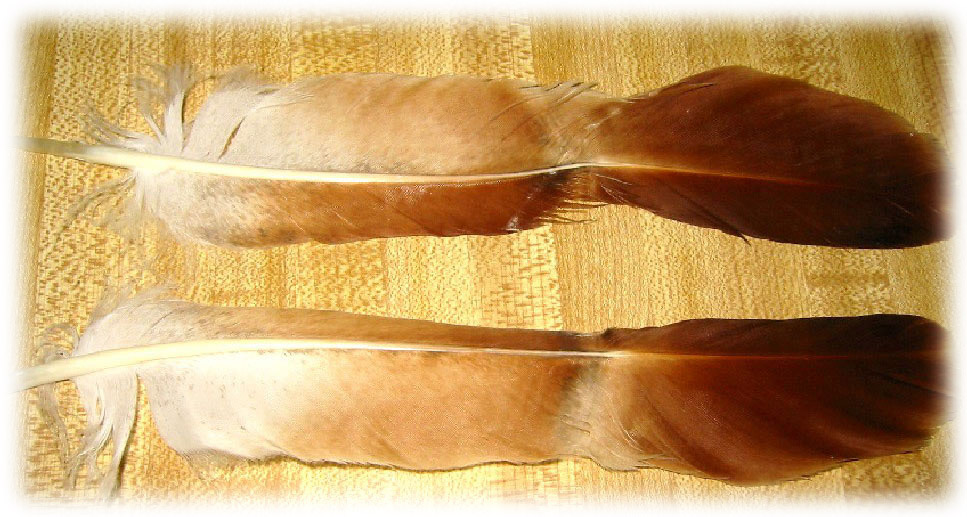
Two feathers from another bird after she survived West Nile Virus infection.
More information on feathers in general:
Plumage and moults - All About Birds: The Basics https://www.allaboutbirds.org/news/the-basics-feather-molt/
Moult and plumage http://www.globalraptors.org/Grin/researchers/uploads/302/moult_and_plumage.pdf
Moult in Birds of Prey: A Review of Current Knowledge and Future Challenges for Research https://bioone.org/journals/ardeola/volume-65/issue-2/arla.65.2.2018.rp1/Moult-in-Birds-of-Prey--A-Review-of-Current/10.13157/arla.65.2.2018.rp1.full